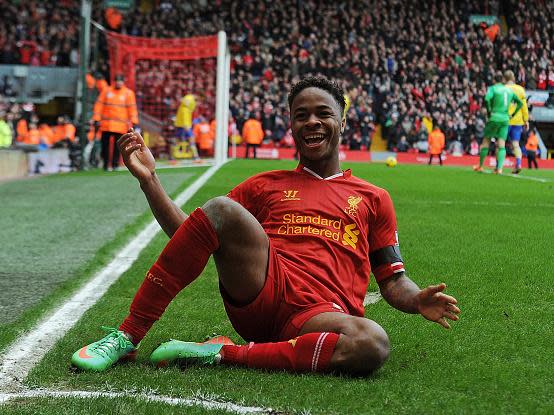Raheem Sterling’s Liverpool scars may never heal – but all he ever wanted was respect

Raheem Sterling is misunderstood and has frequently been misrepresented but the Manchester City winger has not helped himself this week. Most of the negative publicity the 24-year-old has endured throughout his career has been undeserved. His fit of petulance and scuffle with Joe Gomez when the England squad gathered at St George’s Park was a self-inflicted wound.
Spats between team-mates at club and international level are not unusual. Bruised egos will heal. The scars Sterling carries from his time at Anfield may never.
Sterling was disappointed by City’s 3-1 defeat by Liverpool on Sunday and left Merseyside with a sense of grievance. Not only did Pep Guardiola and his team feel that refereeing decisions had gone against them and in the home side’s favour, but Sterling was relentlessly booed and subjected to chants of “one greedy b*****d.” The Kop feel scorned because their former player departed for the Etihad four years ago. No fans enjoy seeing the return of a man who left in rancorous circumstances but it was hardly greed that drove Sterling away from Merseyside.
The England forward was brought to Anfield from Queens Park Rangers’ academy at the age of 15 and his first two years at the club were a generally positive experience. Things changed when Brendan Rodgers took over in 2012. The Northern Irishman managed to make a mess of his first summer transfer window and left himself short of attacking players. Sterling, at just 17, was drafted in to play in the first team more often than had been anticipated. He made 24 Premier League appearances during the campaign and was treated like a fully-fledged member of the squad. Except in one area: renumeration.
How bad was the disparity? The youngster was being paid in the region of £35,000 per week. In his European debut, a Europa League qualifying match against Gomel in Belarus, he replaced Joe Cole, whose contract was worth £140,000 per week. Another option on the wing for Rodgers was Stewart Downing, who played five more league games than Sterling. Downing was pocketing more than twice the salary.
In any workplace big disparities in salaries cause unhappiness and football dressing rooms are no different. As Sterling improved and began to show signs of developing into a top-class player, Liverpool seemed slow to recognise his potential. Rodgers called him “the best young player in Europe,” but still played him at wing back – on both sides – in a team that limped to sixth place in 2014-15 after finishing second to City the previous season. Sterling missed just three league games but was too often deployed in unsuitable roles.
Fenway Sports Group, the American owners, saw Daniel Sturridge as the face of the club in the post-Steven Gerrard era and made the former Chelsea striker the biggest earner on £140,000 a week. Sturridge played just 12 league matches in 2014-15 (he would only manager 14 in the following campaign). Sterling, by now an England international, wanted parity. He was offered £40,000 per week less.
The ‘I’d play for nothing’ brigade will be outraged by the figures but football is a profession, not a hobby. Wages reflect status. Sterling was taken for granted and undervalued. He knew it.

By this point, media hostility had created a troubled image for a young man barely out of his teens. Roy Hodgson, the England manager at the time, suggested that Sterling had claimed he was too tired to represent his country. He had not but the slur stuck. Hodgson was pursuing a vendetta against Liverpool’s medical department after run-ins with Anfield’s doctors during his time in charge on Merseyside. Sterling was collateral damage.
Some of the newspaper coverage of the player over the years has had disturbing racial and class undertones. Sterling was criticised for buying his mother a “blinging” house, “complete with jewel-encrusted bathroom” according to the headline. By that time he had moved to City for £49 million and was established as a symbol of everything that is wrong about football. The Kop were not the only ones that booed him
Sterling undoubtedly misjudged his exit from Anfield. He conducted a televised interview while still a Liverpool player that hardened attitudes on all sides. In it he talked about leaving to win trophies rather than money and he has been rewarded with both. The medals have piled up – two titles, one FA Cup and two League Cups. Everyone at Anfield who was involved in letting Sterling leave for what now looks like a paltry sum should be grateful for the arrival of Jurgen Klopp and the team the German has created. Without the Champions League success this year, Sterling’s departure would look like one of the worst bits of business in the club’s history. It still looks pretty dire.
Sterling’s anger towards Liverpool is completely understandable, even if his behaviour towards Gomez is not. Over past year or so the media mood has turned in the City winger’s favour. His dignity in the face of what appeared to be racist abuse at Chelsea last season won him new admirers and his performances for England have elevated his status. Gareth Southgate could afford to be without him last night against Montenegro but will need Sterling next year in the Euros if the Three Lions are to have a realistic chance of winning the tournament.
Whenever he appears in front of the Kop, Sterling will be labelled a greedy b*****d. That is not what hurts. It’s the lack of respect from the fans, management and owners during his time as a Liverpool player that rankles. He will remember that when the fracas with Gomez is forgotten.
Read more
Why this week has been about more than Sterling and Gomez
Podcast: Reacting to Sterling vs Gomez
Southgate’s hardline stance on Sterling reminder of England’s maturity

 Yahoo Sport
Yahoo Sport 




































